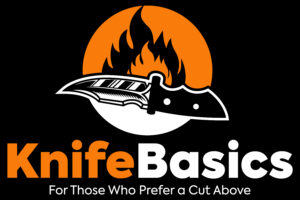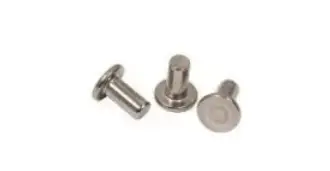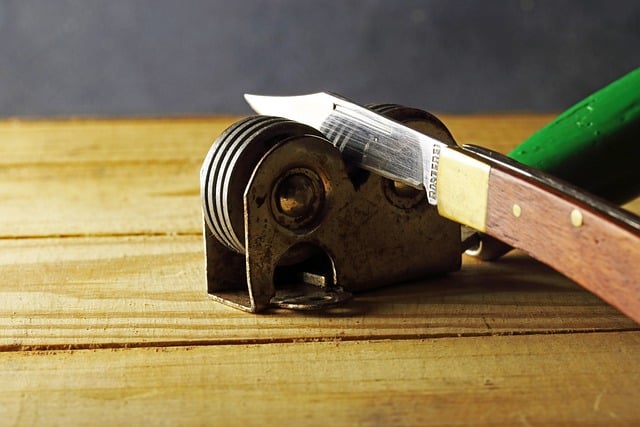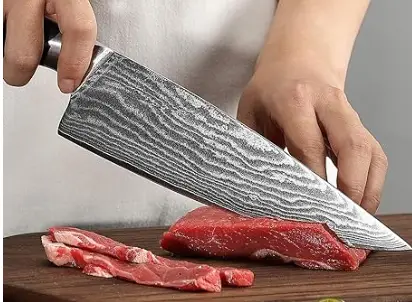Need a comprehensive reference on rivets for knife handles? Your search ends here! If you want to know how to rivet your knife handles together securely, this article will take you on a tour of the many different kinds of rivets, how they work, and some helpful hints for using them.
Whether you’re an expert or a weekend warrior when it comes to making knives, using the correct rivets is essential for long-term stability and durability. Learn the ins and outs of solid, tubular, and semi-tubular rivets, as well as their benefits and common uses, with the help of our comprehensive guide.
We will also go over details like material compatibility, load-bearing capability, and installation convenience as they pertain to rivet selection. If you’re well-informed, you may choose an attachment for your knife handles that will last a long time and be dependable.
Mark this page and get ready to delve in if you want to discover everything about rivets for attaching knife handles. Give yourself the tools you need by learning how to make strong and reliable knife sheaths.
Advantages of Rivets as an Attachment Method for Knife Handles
When fastening knife handles, rivets provide a number of advantages. The first thing they do is keep the handle from coming loose from the blade; they’re really sturdy and sturdy. Knives that are used often and severely, like survival knives or culinary knives, need this extra care.
Additionally, rivets for knife handles disperse the stress throughout the handle, eliminating possible sites of failure that may loosen or break with time. For knives used for tough jobs, where a firm grasp is required, this is of the utmost importance.
Riv fasteners have the added benefit of being able to endure harsh environments. Riveted handles are resistant to heat, dampness, and other harsh conditions, making them ideal for use in the kitchen or on outdoor expeditions.
Furthermore, rivets give knife handles a polished look. You may pick the ideal rivet to match the style and aesthetics of your knife from the wide variety of designs, finishes, and materials available.
In terms of longevity, steadiness, weight distribution, and aesthetic appeal, rivets are the way to go for attaching knife handles.
Common Rivet Types for Knife Handle Fasteners
Solid, tubular, and semi-tubular rivets are the three most frequent kind of rivets used for attaching knife handles. There are distinct qualities and uses for each kind.
A variety of uses have called for solid rivets, the oldest and most common kind of rivet. A solid cylindrical shaft, terminating in a head, is their basic construction. To install a solid rivet, you must follow a certain procedure that includes heating the shaft and then hammering it into position to form a lasting connection.
The dependability and strength of these rivets are well-known. Their installation is so secure that even the most robust knives and equipment will have no trouble keeping them in place. In addition to being vibration-resistant, solid rivets keep the handle firmly fastened, even during heavy usage.
Rods with a Holes
A tubular rivet is characterized by a hollow, cylindrical shaft that has a head attached to one end, as the name implies. Their adaptability and portability make them a favorite material for knife handles. When using tubular rivets, the shaft is inserted into pre-drilled holes and the open end is compressed to provide a secure connection.
Not only are these rivets simple to install, but they also have great tensile strength. Wood, plastic, and even certain metals may be used for knife handles with these. With the rivet head flush against the material, tubular rivets give the handle a clean and completed look.
Semi-Tubular Fasteners
Although they have certain similarities with tubular rivets, semi-tubular rivets have a partly hollow shaft. To make a strong bond, the rivet’s open end is flared or enlarged. When a strong bond has to be formed yet the material being fastened is too delicate for a standard solid rivet, this rivet style is often used.
For a wide range of knife handle materials, semi-tubular rivets are the way to go because of their high load-bearing capability. They are a favorite among both expert and do-it-yourself knife builders due to the sturdy and dependable attachment they give.
Related: The Best Knife Blades: Sharpen Your Culinary Skills
Suiting Your Knife Handle to the Appropriate Rivet Size and Material
For a solid connection to your knife handle, it is essential to choose the correct size and substance for your rivets. Before you make a final choice, think about the following.
The Importance of Size
Consider the knife handle material’s thickness while selecting the rivet size. A rivet’s ideal length is two-thirds of the way through the material of the handle plus enough to create a head on the opposite side.
Remember that the rivet’s diameter should match the handle material’s thickness exactly. Using a rivet that is too thick could cause the material to split or break, while using one that is too thin might lead to a poor connection.
Important Things to Think About
The rivet’s substance should be harmonious with the handle’s and blade’s respective materials. A good illustration of this would be the use of stainless steel rivets to attach a hardwood handle to a blade made of stainless steel.
Rivets are often made of metals such as aluminum, brass, and stainless steel. Stainless steel rivets are widely used due to their high strength and resistance to corrosion. Decorative knife handles often have brass rivets for their aesthetically pleasing finish. When saving weight is an important consideration, aluminum rivets are a great choice.
If you want your knife handle to look good, last a long time, and function well, you should think about all of these things before you choose the rivet material.
Rivet-Assembly Instructions for Knife Handles
Careful planning and execution are required when utilizing rivets for knife handles. If you want to establish a safe and professional connection, follow these steps.
1.First, get the handle material ready by shaping and sanding it to perfection. In order for the rivets to fit properly, there must be no rough edges or other flaws.
2. Mark the hole locations: Take measurements of the handle material and the blade tang to determine where you want the rivet holes. To aid in guiding the drill bit, make a little indentation at each designated point using a center punch.
3. Drill the holes: In order to produce the holes in the handle material and the blade tang, use a drill bit that is correctly sized. Make sure the holes you drill are clean and straight so the rivets can fit properly.
4. Insert the rivets. Place the rivet heads on the handle material and the shaft through the blade tang. Then, insert the rivets into the holes.
5. Put the rivets in place by using a rivet setter or a hammer and anvil. Press down evenly and firmly on the rivet shaft until a tight connection is formed. Be cautious not to over-compress the rivet, as doing so might harm the material used for the handle.
6. Finish and trim: If needed, use a file or grinder to shorten the rivets. If you want your handle to seem professional, check that the rivet heads are flush with the material.
If you follow these instructions to the letter, your knife handle will be permanently affixed and ready to take a beating.
Methods for a Strong and Durable Knife Handle Fastener
Follow these guidelines for a safe and long-lasting knife handle attachment:
1. Pick the correct rivet size: Before purchasing, check the thickness and material of your handle to determine which rivet size will work best. A sturdy and reliable fastening may be achieved with a rivet of the correct size.
2. Don’t drill holes that are too big or use a drill bit with a countersink to make chamfered holes; this will keep the handle material from cracking or breaking.
3. Get the correct tools: For accurate and efficient rivet installation, get high-quality hammers, anvils, and rivet setters. If you have the correct equipment, you may do the task more easily and avoid damaging the handle or blade.
4. Try using epoxy glue on the handle material prior to riveting for increased strength and stability. When you do this, the rivets and the handle will become permanently attached.
5. Maintain the system on a regular basis. Check for loose or worn rivets and the connection to the handle on a regular basis. To keep the connection secure, you may need to tighten or replace the rivets. In order to keep your knife handle attachment safe and dependable for a long time, use these tips and tactics.
How to Use Rivets for Knife Handles Properly
Even though rivets for knife handles are a simple way for connection, there are a few pitfalls to watch out for:
First, make sure the rivets are the right size for the handle material. If they are too big or too little, the connection won’t be as strong and stable. Make sure the rivet size is proportional to the handle material thickness at all times.
The second issue is the misalignment of the holes, which might lead to a weak or unequal connection. Before you drill the holes in the handle material and the blade tang, be sure to mark them precisely.
Thirdly, rivets should not be over compressed as this could cause harm to the handle material or the development of unneeded stress points. To fix the rivets securely without using too much effort, push down evenly and firmly.
Fourth, utilizing materials that are incompatible: When rivets are used with materials that are not suitable with the handle or blade, it might cause corrosion, attachment weakening, or cosmetic problems. Select materials with care, making sure they are appropriate for the task at hand.
Finally, ignoring maintenance: To ensure long-term durability, it is vital to examine and repair the rivets and handle attachment regularly. A knife’s performance and safety are jeopardized when maintenance is neglected, leading to weak or loose connections. If you want your knife handle attachment to last, make sure you don’t do these typical blunders.
You may also be interested in Best Benchmade Knife
Advice on Keeping Riveted Knife Handles in Good Condition
Optimal condition of rivets for knife handles may be maintained by following these care and maintenance tips:
1. Get a good cleaning in: Remove any dirt, debris, or other impurities from the knife handle and rivets on a regular basis. Carefully clean the handle using a gentle detergent, warm water, and a delicate brush or cloth, being careful not to harm the rivets.
2. Make sure the knife handle is completely dry after cleaning to avoid any moisture accumulation. Corrosion or gradual rivet weakening may occur in damp environments.
3. Coat the handle material and rivets with a protective coating. You may use wax or oil for this purpose. These coatings offer further defense against the elements, corrosion, and everyday use.
4. Keep away from strong chemicals: Bleach and other strong solvents might damage the knife handle and rivets. The material of the handle and the rivets might be damaged or corroded by these substances.
5. Properly store: Keep your knives in a clean, dry place when they are not in use. The rivets and handle material may be compromised if stored in places with excessive humidity or sudden changes in temperature.
A knife handle fastened with rivets will last longer and work better if you take care of it according to these guidelines.
Where Can I Find Good Rivets for My Knife Handle Accessories?
- Product Information:Size: 5/16 inch head, 5/8 inch long shaft. These knife making bolsters are easy to store, the right size, won't take up too much space, the product sets are selective and meet your daily use and replacement.
- Suitable for All Kinds of Knives: these rivets are designed to fit for all kinds of knife handles and tools, such as steak knives, chef's knives, butcher knives, traditional hunting knives, slicing knives, chopping knives, meat choppers, fruit knives and other common knives we see around us, which is a good helper for decorating kitchen tools and DIY hobbies.
- Superor Quality: These brass rivets are made of high quality materials, sturdy and durable, corrosion and rust resistant, exquisite craftsmanship, quality workmanship, not easy to be deformed with fading or breaking, the product is smooth, beautiful and firm, and widely applicable.
- Easy to Install: Drill a hole in the surface of the mounting shank and then tighten the screw with a flat head screwdriver, the two rivet parts combine under pressure and they will form a bonded joint and stay together indefinitely. Sand or file down any protruding excess to create your own uniquely attractive knife.
- Thoughtful Service: please confirm the size specification before purchase, the product is brand new and unopened, if you have any questions please contact us, we will reply you as soon as we receive the message.
- Package include : 9Pairs X Kitchen Knife Handle Clip Rivet
- Size:1.4*0.7cm/0.55*0.28inch
- The Rivet Is Made Of Stainless Steel Hollow Material, Thick And Durable, And The Kitchen Knife Will Not Loosen After Use
- Rivets Can Be Used On Kitchen Knives. The Thickness Of The Blade Of The Kitchen Knife Is About 3mm. It Doesn’t Matter If The Hole Of The Kitchen Knife Is Relatively Small, It Can Make Your Kitchen Knife Stronger
- How To Use: Nail It On The Hole Of The Kitchen Knife With A Hammer
- Reliable Quality: the knife handle pins are made of quality brass and stainless steel, anti rust and anti corrosion, wear resistant, hard, strong, repairable, not easy to deform, fade or break, and can serve you for a long time
- Package Quantity: the package comes with 10 sets of brass bracket bolt fasteners and 10 sets of stainless steel bracket bolt fasteners, each set including a screw and a stud; The quantity is enough to meet your daily use and replacement needs
- Dimension Information: the knife screws measure approx. 25 mm/ 0.98 inches in length, with a rivet shaft outer diameter of approx. 4 mm/ 0.16 inches, and rivet head outer diameter of approx. 6 mm/ 0.24 inches
- Easy to Assemble: drill a hole on the surface of the object where the blind rivet is to be installed, then tighten the rivet with a screwdriver; If you need to finish the handle pin, you can polish the protruding excess into a solid handle pin look
- Wide Range of Uses: the knife making kit in 2 styles is useful for DIY more scenes and props, such as slicing knives, meat cleavers, vegetable cutters, fruit knives, etc., making the tool more robust and simple
Several alternatives are available for acquiring high-quality rivets that may be used to connect knife handles. Take a look at these sources:
1. Shops catering to knife manufacturers and enthusiasts: These shops often provide a large selection of rivets made for attaching knife handles. Stores like this usually provide a wide selection of sizes, materials, and finishes to cater to everyone’s tastes and requirements.
2. Amazon and eBay are just two examples of online marketplaces where you can easily find and buy rivets for attachments to knife handles. To guarantee quality and dependability, read reviews written by previous customers and look into the seller’s reputation.
3. Metalworking providers: Hardware shops and metalworking suppliers may have rivets that are appropriate for attaching knife handles. Depending on your needs, you may discover the ideal rivet among these vendors’ many options in terms of material and size.
4. Communities and forums dedicated to knifemaking: If you’re a member of one of these groups, you can talk to other people who make knives and get their advice on where to get good rivets. If you ask any seasoned knifemakers for recommendations, they should be able to point you in the direction of the finest rivets for your project. If you want your rivets to stay put on your knife handle, you should use high-quality, dependable rivets.
Final Thoughts on Rivets as an Attachment Method for Knife Handles
Finally, if you want your knife handle attachments to be strong and solid, you need to use rivets. Get a flawless and long-lasting connection for your knife handles by learning about the features and advantages of various rivet types, taking size and material compatibility into account, and using the right installation procedures.
If you want your knife handles to last a long time and work well, avoid the usual errors and take care of them regularly. Whether you’re a professional knife maker or just someone who loves to do it himself, rivets are the way to go for a handle that is both sturdy and aesthetically pleasing.
You can now confidently choose and install the ideal rivets for your knife handle attachments, thanks to the information in this comprehensive guide. Go ahead and demonstrate your skill with knives that not only function well but also have sturdy and secure connections. Enjoy crafting knives!personal belongings






